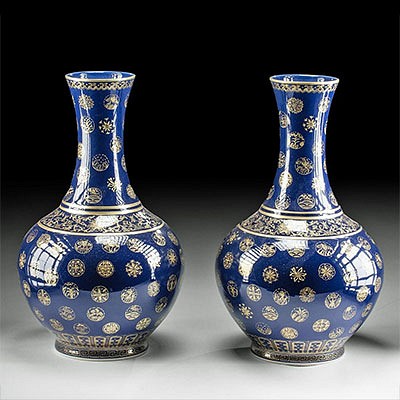18th C. Burmese Silver Buddha on Lotus Throne
Lot 100
About Seller
Artemis Fine Arts
686 S Taylor Ave, Ste 106
Louisville, CO 80027
United States
Selling antiquities, ancient and ethnographic art online since 1993, Artemis Gallery specializes in Classical Antiquities (Egyptian, Greek, Roman, Near Eastern), Asian, Pre-Columbian, African / Tribal / Oceanographic art. Our extensive inventory includes pottery, stone, metal, wood, glass and textil...Read more
Categories
Estimate:
$1,300 - $1,950
Absentee vs Live bid
Two ways to bid:
- Leave a max absentee bid and the platform will bid on your behalf up to your maximum bid during the live auction.
- Bid live during the auction and your bids will be submitted real-time to the auctioneer.
Bid Increments
| Price | Bid Increment |
|---|---|
| $0 | $25 |
| $300 | $50 |
| $1,000 | $100 |
| $2,000 | $250 |
| $5,000 | $500 |
| $10,000 | $1,000 |
| $20,000 | $2,500 |
| $50,000 | $5,000 |
| $100,000 | $10,000 |
| $200,000 | $20,000 |
About Auction
By Artemis Fine Arts
May 6, 2021
Set Reminder
2021-05-06 10:00:00
2021-05-06 10:00:00
America/New_York
Bidsquare
Bidsquare : Art of Asia | Antiquity to Present
https://www.bidsquare.com/auctions/artemis-gallery/art-of-asia-antiquity-to-present-6908
Featuring antiquities and works of art ranging from the third millennium BCE to the present. From West to East including the Near East and Central Asia, China, Japan, Korea and South and Southeast Asia. Including jades, bronzes, lacquer, textiles, paintings, prints, sculpture, ceramics, more! Artemis Fine Arts info@artemisgallery.com
Featuring antiquities and works of art ranging from the third millennium BCE to the present. From West to East including the Near East and Central Asia, China, Japan, Korea and South and Southeast Asia. Including jades, bronzes, lacquer, textiles, paintings, prints, sculpture, ceramics, more! Artemis Fine Arts info@artemisgallery.com
- Lot Description
Southeast Asia, Burma, ca. 18th to 19th century CE. A remarkable silver statue of Buddha seated in lotus position atop an integral plinth. Dressed in a robe, the tranquil deity is shown with a slender torso and bulbous legs as his right hand holds his right leg and his left rests, cupped in his lap. The Buddha possesses a serene expression, nicely modeled with steadfast eyes, and presents wonderful characteristic details such as a tightly curled coiffure, an ushnisha headdress symbolizing the power of his enlightenment, and elongated ears signifying his renunciation of materialistic wealth. His tri-tiered plinth is adorned in elaborate relief designs with an undulating motif at the top representing the petals of a lotus blower. Note that the bottom of this sculpture is sealed with resin. Religious statues such as this one must be formally consecrated in a ritual known as buddhabhiseka (or "anay gaza tin" in Burmese) in which followers place offerings, such as candles, flowers, incense, flags, or papers with written prayers, inside of the statue and then seal it with wax or resin. Size: 3.25" W x 6.25" H (8.3 cm x 15.9 cm); Silver quality: 95.5%; Weight: 387 grams
One interpretation of the Buddha's long ears: When Buddha was a prince, he wore heavy ear jewelry. Once he became an ascetic, Prince Gautama renounced all materialistic wealth, but his ears remained stretched. Another interpretation is that these long ears symbolize compassion, for the enlightened one can hear the cries of suffering throughout the world.
Buddhas can display various mudras (hand gestures/poses) that represent historical moments in Buddha's life, forms of meditation, or a symbolic combination of both. This Buddha displays the Bhumisparsha (earth touching) mudra, with the right hand placed over the right knee, palm inward, reaching towards his lotus throne and beyond this, the earth. He places his left hand in his lap with the palm upwards toward the celestial realm. This mudra represents the moment of his awakening, as Buddha defeated the demon Mara, and claimed the earth as his witness to his enlightenment. An impressive example of Buddhist visual culture, replete with immense artistry and numerous layers of meaning. A breathtaking symbol of peace, representing wisdom, balance, generosity, and compassion.
Provenance: private Lake City, Colorado, USA collection
All items legal to buy/sell under U.S. Statute covering cultural patrimony Code 2600, CHAPTER 14, and are guaranteed to be as described or your money back.
A Certificate of Authenticity will accompany all winning bids.
We ship worldwide and handle all shipping in-house for your convenience.
#163826Petite fissures on both knees with miniscule amounts of loss. Chips and repairs to periphery of base with light restoration over break lines. Repair to verso with break line visible. Missing proper right ear. Some light softening of detail commensurate with age and use. Otherwise, excellent with rich patina throughout.Condition
- Shipping Info
-
All shipping is handled in-house for your convenience. Your invoice from Artemis Gallery will include shipping calculation instructions. If in doubt, please inquire BEFORE bidding for estimated shipping costs for individual items.
-
- Buyer's Premium



 EUR
EUR CAD
CAD AUD
AUD GBP
GBP MXN
MXN HKD
HKD CNY
CNY MYR
MYR SEK
SEK SGD
SGD CHF
CHF THB
THB














